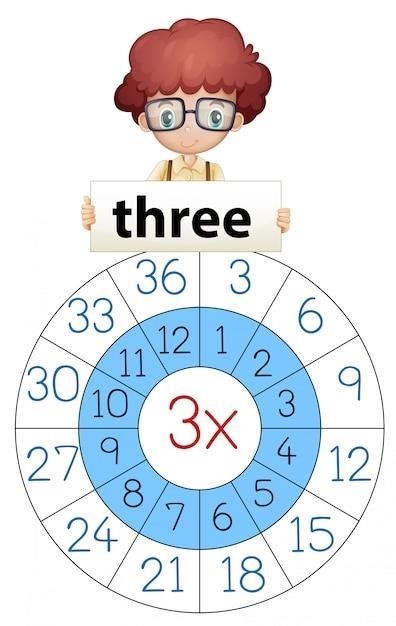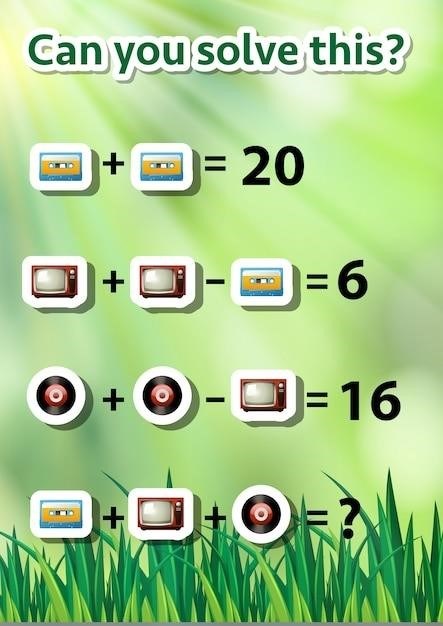
multiplying and dividing integers pdf
Multiplying and Dividing Integers⁚ A Comprehensive Guide
This comprehensive guide will delve into the fundamental concepts of multiplying and dividing integers, providing a clear understanding of the rules and principles involved. We’ll explore the rules for multiplying and dividing integers, including examples and practice problems to solidify your understanding. This guide will also cover real-world applications of these operations, common mistakes to avoid, and additional tips and tricks for success.
Introduction to Integers
Integers are whole numbers, both positive and negative, and include zero. They are fundamental building blocks in mathematics and are essential for understanding various mathematical concepts, including algebra, geometry, and calculus. Integers are often represented on a number line, where zero is at the center, positive integers extend to the right, and negative integers extend to the left. Understanding integers is crucial for performing operations like addition, subtraction, multiplication, and division, which are used in numerous real-world applications.
The concept of integers is used in various everyday situations. For instance, when dealing with temperatures, we often encounter negative integers. If the temperature drops below zero degrees Celsius, we use negative numbers to represent the temperature. Similarly, financial transactions involving debts or withdrawals often involve negative integers. In accounting, a negative balance represents a deficit or an outstanding debt. Integers are also used in computer programming, where they are used to represent data, control program flow, and perform calculations.
The study of integers is essential for developing a strong foundation in mathematics. It provides the building blocks for more advanced mathematical concepts and helps students develop critical thinking and problem-solving skills. By understanding the rules and principles of integers, students can confidently tackle various mathematical challenges, both in the classroom and in real-world applications.
Rules for Multiplying and Dividing Integers
Multiplying and dividing integers follow specific rules that determine the sign of the result. These rules are based on the concept of opposites and are essential for performing these operations accurately. Here’s a breakdown of the rules⁚
- Multiplying/Dividing Integers with the Same Sign⁚ When multiplying or dividing two integers with the same sign (both positive or both negative), the result is always positive. For example, 3 x 6 = 18 and -5 x (-4) = 20. This rule is based on the idea that multiplying two positive numbers results in a positive number, and multiplying two negative numbers effectively cancels out the negative signs, resulting in a positive number.
- Multiplying/Dividing Integers with Different Signs⁚ When multiplying or dividing two integers with different signs (one positive and one negative), the result is always negative. For example, 3 x (-6) = -18 and -5 x 4 = -20. This rule is based on the concept that multiplying a positive number by a negative number results in a negative number, and vice versa.
Understanding these rules is crucial for accurately performing operations with integers. These rules are applicable to various mathematical problems and real-world applications, ensuring consistent and correct results.
Examples of Multiplying and Dividing Integers
Let’s solidify your understanding of multiplying and dividing integers with some concrete examples. These examples will illustrate how the rules we discussed earlier apply to different scenarios.
Example 1⁚ Multiplying Integers with the Same Sign
Calculate the product of 5 and 7⁚ 5 x 7 = 35. Both integers are positive, so the product is positive.
Example 2⁚ Multiplying Integers with Different Signs
Calculate the product of -3 and 4⁚ -3 x 4 = -12. One integer is negative, and the other is positive, so the product is negative.
Example 3⁚ Dividing Integers with the Same Sign
Calculate the quotient of 12 and 4⁚ 12 / 4 = 3. Both integers are positive, so the quotient is positive.
Example 4⁚ Dividing Integers with Different Signs
Calculate the quotient of -10 and 2⁚ -10 / 2 = -5. One integer is negative, and the other is positive, so the quotient is negative.
These examples showcase the practical application of the rules for multiplying and dividing integers. By working through these examples, you can gain confidence in applying these rules to various problems.
Applying the Rules
Now that you’ve grasped the fundamental rules of multiplying and dividing integers, let’s put them into practice with some real-world scenarios. These examples will demonstrate how these operations are used in everyday situations.

Scenario 1⁚ Temperature Change
Imagine the temperature dropping 5 degrees Celsius each hour. If the temperature is currently 10 degrees Celsius, what will it be after 3 hours? You can use multiplication to calculate the total temperature change⁚ 5 degrees/hour x 3 hours = -15 degrees Celsius. The temperature will drop by 15 degrees, resulting in a final temperature of -5 degrees Celsius.
Scenario 2⁚ Sharing Pizza
You have a pizza with 12 slices and want to divide it equally among 3 friends. You can use division to determine the number of slices each friend receives⁚ 12 slices / 3 friends = 4 slices per friend. Each friend gets 4 slices of pizza.
Scenario 3⁚ Financial Transactions
You deposit $20 into your bank account each week. After 4 weeks, how much money will you have added to your account? Multiplication can be used to calculate the total deposit⁚ $20/week x 4 weeks = $80. You’ll have added $80 to your bank account.
These scenarios illustrate how multiplying and dividing integers are relevant in everyday life. From calculating temperature changes to sharing pizza or managing finances, these operations are essential tools for understanding and solving practical problems.
Real-World Applications of Multiplying and Dividing Integers
Beyond textbook examples, multiplying and dividing integers have a wide range of practical applications in our daily lives. Understanding these operations allows us to make informed decisions and solve real-world problems.
Finance⁚ Whether it’s budgeting your monthly expenses, calculating interest on a loan, or determining the cost of a purchase after a discount, multiplying and dividing integers play a crucial role. For instance, if you want to calculate the total cost of buying 5 items at $10 each, you simply multiply 5 x $10 = $50.
Measurement and Conversion⁚ Converting between units of measurement often involves multiplying or dividing integers. For example, if you need to convert 100 centimeters to meters, you divide by 100, resulting in 1 meter. Similarly, if you want to calculate the area of a rectangle with a length of 8 meters and a width of 5 meters, you multiply 8 x 5 = 40 square meters.
Time Management⁚ Time management involves understanding the relationship between hours, minutes, and seconds, which often necessitates multiplication and division. For example, if you need to calculate the total time spent on a task that takes 15 minutes, you can multiply 15 minutes x 4 = 60 minutes, or 1 hour.
Problem Solving⁚ Many everyday problems require the application of multiplying and dividing integers. For example, if you need to share 24 cookies equally among 6 friends, you would divide 24 cookies / 6 friends = 4 cookies per friend.
These are just a few examples of how multiplying and dividing integers are used in the real world. By understanding these operations, you gain a powerful tool for navigating everyday situations and making informed decisions.

Common Mistakes to Avoid
While multiplying and dividing integers seem straightforward, common mistakes can easily arise, leading to incorrect answers. Here are some typical errors to be mindful of⁚
Ignoring the Sign Rules⁚ One of the most frequent mistakes is forgetting the rules for multiplying and dividing integers with different signs. Remember, when multiplying or dividing integers with the same sign (both positive or both negative), the result is always positive. However, when the signs are different (one positive and one negative), the answer is always negative.
Misinterpreting Parentheses⁚ Parentheses play a crucial role in integer operations. It’s essential to understand that a negative sign outside parentheses applies to the entire expression inside. For example, ― (3 x 4) is not the same as (-3) x 4. The former implies multiplying 3 and 4 first, then negating the result, while the latter means multiplying -3 and 4.
Incorrect Order of Operations⁚ Remember the order of operations (PEMDAS/BODMAS) when dealing with complex expressions involving integers. Parentheses/Brackets, Exponents/Orders, Multiplication and Division (from left to right), Addition and Subtraction (from left to right). Failing to follow this order can lead to incorrect results.
Neglecting to Simplify⁚ After performing multiplication or division, ensure you simplify the result if possible. For example, 12 / -4 = -3, not 12/-4.
By being aware of these common mistakes and practicing diligently, you can avoid errors and achieve accuracy in your integer operations.
Practice Problems
Practice makes perfect when it comes to mastering multiplying and dividing integers. Here are some practice problems to test your understanding and help you solidify your skills⁚
Multiplication⁚
- 5 x (-7) = ?
- (-3) x (-8) = ?
- (-6) x 4 = ?
- 9 x (-2) = ?
Division⁚
- 15 / (-3) = ?
- (-24) / 6 = ?
- (-36) / (-9) = ?
- 28 / (-7) = ?
Challenge Problems⁚
- (-2) x (-5) x 3 = ?
- 16 / (-4) x (-2) = ?
- (-3) x (4 ⎻ 7) = ?
Solutions to these practice problems can be found online or in various math textbooks. Working through these problems will help you identify areas where you may need further practice and build confidence in your ability to handle integer operations accurately.
Printable Worksheets
Printable worksheets are a fantastic resource for students who want to practice multiplying and dividing integers. These worksheets offer a structured way to work through problems and track progress. They are readily available online and can be customized to meet specific learning needs. Here are some key benefits of using printable worksheets⁚
- Reinforcement⁚ Worksheets provide repeated practice, helping students solidify their understanding of integer operations.
- Self-Paced Learning⁚ Students can work at their own pace, addressing areas where they need more practice.
- Immediate Feedback⁚ Worksheets often include answer keys, allowing students to check their work and identify areas for improvement.
- Variety⁚ Worksheets can include different types of problems, from simple multiplication and division to more complex expressions with multiple operations.
When choosing printable worksheets, consider the following⁚
- Difficulty Level⁚ Select worksheets appropriate for the student’s current skill level.
- Format⁚ Choose worksheets that are easy to read and understand, with clear instructions and well-organized problems.
- Content⁚ Ensure the worksheets cover the specific concepts and skills being learned.
Printable worksheets are a valuable tool for enhancing learning and reinforcing skills in multiplying and dividing integers. They offer a flexible and engaging approach to practice, allowing students to progress at their own pace and gain confidence in their mathematical abilities.
Online Resources
The internet is a treasure trove of resources for learning about multiplying and dividing integers. From interactive tutorials to engaging games, there are countless online options to enhance understanding and make learning fun. Here are some key benefits of using online resources⁚
- Accessibility⁚ Online resources are readily available anytime, anywhere, making learning convenient and flexible.
- Variety⁚ Online resources offer a diverse range of learning styles, from video lessons to interactive simulations, catering to different preferences.
- Immediate Feedback⁚ Many online resources provide instant feedback on answers, allowing students to track progress and identify areas for improvement.
- Engaging Content⁚ Online resources often incorporate multimedia elements and interactive features to make learning more engaging and enjoyable.
Here are some types of online resources that can be helpful for learning about multiplying and dividing integers⁚
- Interactive Tutorials⁚ Websites and apps provide step-by-step instructions and examples, guiding students through the process of multiplying and dividing integers.
- Practice Problems⁚ Online platforms offer a wide range of practice problems, allowing students to test their understanding and develop their skills.
- Educational Games⁚ Games designed to teach math concepts can make learning fun and engaging, helping students master integer operations through interactive challenges.
- Video Lessons⁚ Online videos from educators and educational institutions provide visual explanations and demonstrations of integer multiplication and division.
Online resources provide a valuable supplement to traditional learning methods, offering a dynamic and engaging way to learn about multiplying and dividing integers.
Additional Tips and Tricks
Mastering the art of multiplying and dividing integers requires not only understanding the rules but also employing a few strategic tips and tricks. Here are some helpful techniques to enhance your problem-solving skills⁚
- Visualize the Number Line⁚ Imagine a number line with zero at the center. Positive numbers are to the right, and negative numbers are to the left. When multiplying or dividing integers, visualize the direction of movement on the number line to determine the sign of the result.
- Think of Groups⁚ Multiplication can be visualized as repeated addition. For example, 3 x (-2) can be thought of as three groups of -2, resulting in -6. This can help understand the concept of multiplying by negative numbers.
- Simplify with Factors⁚ When multiplying or dividing integers, look for common factors to simplify the calculations. For instance, 12 x (-5) can be simplified by factoring 12 as 4 x 3, resulting in 4 x 3 x (-5) = -60.
- Use the Distributive Property⁚ The distributive property can be applied to simplify expressions involving multiplication and division. For instance, 5 x (2 + 3) can be expanded as (5 x 2) + (5 x 3) = 10 + 15 = 25.
- Practice, Practice, Practice⁚ The more you practice, the more confident you’ll become in applying the rules and tips. Work through a variety of problems, gradually increasing the complexity as you gain proficiency.
By incorporating these tips and tricks into your practice, you’ll not only improve your understanding of integer operations but also gain the confidence to solve more complex problems with ease.
Understanding the rules and strategies for multiplying and dividing integers is crucial for success in mathematics. This guide has provided a comprehensive overview of these operations, covering the fundamental principles, examples, and real-world applications. By mastering the concepts of multiplying and dividing integers, you’ll not only strengthen your mathematical foundation but also develop valuable problem-solving skills that are applicable in various areas of life.
Remember, practice is key to achieving mastery. Work through the examples provided, explore additional practice problems, and utilize online resources to solidify your understanding. With consistent effort and a clear understanding of the rules, you’ll be well-equipped to tackle any challenge involving multiplying and dividing integers.
As you progress, don’t hesitate to seek assistance from teachers, tutors, or online resources if you encounter difficulties. Mathematics is a subject best learned through exploration, experimentation, and collaboration. Embrace the journey of learning and enjoy the satisfaction of mastering this essential mathematical skill.
Comments (0)